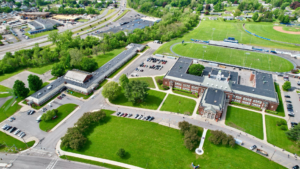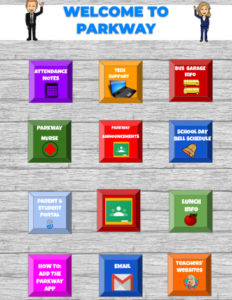“Relationships Matter”: Whitesboro Middle School Campus Case Study Findings Now Available
By K.C. Wilcox and John Egresits
This blog announces another NYKids 2022 case study on the impacts of the COVID-19 pandemic on the education workforce. It highlights key take-aways from the Whitesboro Middle School campus in the Whitesboro Central School District.
The Study
As described in previous blogs, NYKids’ research team has been analyzing data for several months and has completed case studies in our study of educators’ responses to the COVID-19 pandemic. The Whitesboro Middle School Campus, including the Parkway School serving grade 6 and the Middle School serving grades 7 and 8, met the criteria for inclusion in this study based on the survey of educators’ responses to the pandemic because it exhibited more positive workforce responses with regard to stress and job satisfaction than other schools in the sample (n=38). With a score of 41.5% compared to an overall sample mean of 36.9% and standard deviation of 15.4%, the Whitesboro Middle School campus qualified as a positive outlier in this study.
Facilitators for Adaptation and Innovation: Highlights from the Whitesboro Middle School Campus Case Study
Proactive, Conscientious, and Caring Leadership
 District and school leaders’ approaches to pandemic related issues were indicated as key drivers for educator adaptation during the pandemic. One of the most important qualities of the school leadership team, as educators described it, was their accessibility. This accessibility took shape in several ways: physically (leaders being outside the building at arrival and dismissal for example); digitally (leaders being on Zoom calls in Google Classrooms and in team meetings); and emotionally (leaders being available for 24/7 phone calls or texts or in school visits to assuage fears or deal with particular problems). This presence sent a meta-message of expectations for everyone to approach pandemic challenges with conscientiousness and care and contributed to a sense of feeling supported. As educators described appreciating this support, leaders reciprocated appreciation for staff’s efforts as well. As an example, a teacher explained,
District and school leaders’ approaches to pandemic related issues were indicated as key drivers for educator adaptation during the pandemic. One of the most important qualities of the school leadership team, as educators described it, was their accessibility. This accessibility took shape in several ways: physically (leaders being outside the building at arrival and dismissal for example); digitally (leaders being on Zoom calls in Google Classrooms and in team meetings); and emotionally (leaders being available for 24/7 phone calls or texts or in school visits to assuage fears or deal with particular problems). This presence sent a meta-message of expectations for everyone to approach pandemic challenges with conscientiousness and care and contributed to a sense of feeling supported. As educators described appreciating this support, leaders reciprocated appreciation for staff’s efforts as well. As an example, a teacher explained,
We do our job, and we work hard, and they [school leaders] appreciate it. And I just feel like, if you need anything… if you needed to take a day because you needed to take care of this personal issue you could go in and tell them… this is what’s going on in my life. I just feel comfortable walking in there [school leaders’ offices]. They [school leaders] truly want to work as a team. During the pandemic, they would come to our team meetings, and they come to team meetings here and now too, but like when we all felt so isolated they were coming to team meetings. They were listening to the struggles we had. They listen. -teacher
Importantly, both the district and Middle School campus leadership team backed up their words of encouragement with the timely provision of supports, technical and otherwise.
Problem-Solving and Innovative Mindsets
Connected to leaders’ proactive, conscientious, and caring qualities and practices, educators and leaders alike described how they approached problem solving and innovating. They expressed how in Whitesboro you are encouraged to “try things out” as one teacher described it, and this was seen as facilitated by clear expectations from leaders about being child and family-centered and collaborative. As one teacher reported,
We are very open to new things, and an advocate for kids. You know, if it’s good for kids, we’re on board. I appreciate the fact that the expectations are very clear. They’re concise and we know what to expect. We know what we’re walking into, we know what we’re getting from them [school and district leaders]. We know they’re backing us. -teacher
This problem-solving and innovative mindset was tested in many different ways throughout the pandemic. The Superintendent described some of the ways they addressed a key problem: technology use.
We had plenty of technology. We had the hotspots. We had the Chromebooks. So we were able to get those in the hands of our students and their families. But what we found is that there were a lot of challenges navigating their use: ‘how do you use it?’ The platforms were sometimes tricky as far as the academic programs that the students were using. We heard that they [students and families] were having difficulty. We created a system of online support for them that they could access 24/7 on our website. We had countless documents there … helping them walk through different technical issues. If they were having a hardware issue, they could submit a ticket and our techs would get in touch with them. They went to their houses and helped. -Superintendent
This problem-solving and innovative approach was fed by norms for being collaborative. Educators at the Middle School campus described ongoing informal collaborations to solve immediate problems – oftentimes related to particular student needs or an instructional adaptation, but they also benefitted from structured time in team meetings to problem solve collectively. This combination of flexibility and cooperativeness fueled staff’s abilities and willingness to collaborate in solving problems.
User-friendly Systems and Communications
Another signature feature of Whitesboro MS campus’ approach to the pandemic was in making user-friendly changes to systems and communications. This was captured in the following quote from a support staff member with regard to how they used a variety of standard practices to ease use of resources and information for staff, students, parents, and caretakers.
 The way that teachers are naming their Google Classrooms needed to be streamlined so that it comes up clearly for kids and for administration. So, we [support staff] can Zoom in to any period, any point in the day. So just things like that— nuanced things that we laid out, had that expectation, so that we could eliminate barriers as best we could for our kids and for our families. – support staff member
The way that teachers are naming their Google Classrooms needed to be streamlined so that it comes up clearly for kids and for administration. So, we [support staff] can Zoom in to any period, any point in the day. So just things like that— nuanced things that we laid out, had that expectation, so that we could eliminate barriers as best we could for our kids and for our families. – support staff member
This attention to how everything from Google Classroom to school and district communications via apps (see Figure) providing important information was in alignment with the Middle School campus’ penchant for taking a caring and empathetic approach.
A Note from the Principal
“Working with Kristen and the team from U of Albany has helped the Whitesboro Middle School Campus in many ways. First, the ability to reflect. Reflecting upon the work that was accomplished on this campus during the pandemic and knowing this work would not have happened without the foundation we had developed with our staff, colleagues and community. Secondly, the opportunity to take a deep dive into our practices at that time; what was essential, what was redundant, what could we do more efficiently. Lastly, this project reinforced what we have been stressing to and with our staff during my nine years here….relationships matter. Being a leader means being a good listener and making tough decisions based on the current data and circumstances.”
– Whitesboro Middle School Campus Principal John Egresits
To see more from this case study please check it out on the NYKids website.
As always, we thank you for your interest in NYKids and invite you to follow us on Twitter, Facebook, and Instagram.
Tag:adaptation, case study, COVID, innovation, Middle school, pandemic
